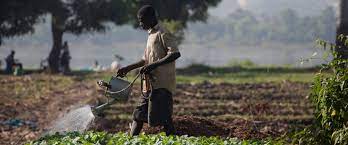Plants require water for photosynthesis, growth, and reproduction. The water used by plants is non-recoverable, because some water becomes a part of the chemical makeup of the plant and the remainder is released into the atmosphere (Pimentel et al. 2004b).
The processes of carbon dioxide fixation and temperature control require plants to transpire enormous amounts of water. The processes of carbon dioxide fixation and temperature control require plants to transpire enormous amounts of water.
Various crops use water at rates between 300 and 2000 L per kilogram (kg) dry matter of crops produced (Pimentel et al. 2004a). The average global transfer of water into the atmosphere by vegetation transpiration from terrestrial ecosystems is estimated to be about 64% of all precipitation that falls to Earth (Pimentel et al. 2004a).
The minimum soil moisture essential for crop growth varies. For instance, US potatoes require soil moisture levels of 25% to 50%; alfalfa, 30% to 50%; and corn, 50% to 70% (Pimentel et al. 2004a). Rice in China is reported to require at least 80% soil moisture (Pimentel et al. 2004a).
Rainfall patterns, temperature, vegetative cover, high levels of soil organic matter, active soil biota, and water runoff all affect the percolation of rainfall into the soil, where it is used by plants.

The water required by food and forage crops ranges from about 300 to 2000 L per kg dry crop yield (Pimentel et al. 2004a).
For instance, in the United States, 1 ha of corn, with a yield of approximately 9000 kg per ha, transpires about 6 million L water per ha during the growing season (Pimentel et al. 2004a), while an additional 1 million to 2.5 million L per ha of soil moisture evaporate into the atmosphere (Pimentel et al. 2004a).
Read Also : On-site Municipal Wastewaters Treatment
This means that the growing season for corn production requires about 800 mm rainfall (8 million L per ha). Even with annual rainfall of 800 to 1000 mm in the US Corn Belt, corn frequently suffers from insufficient water during the critical summer growing period (Pimentel et al. 2004a).
A hectare of high-yielding rice requires approximately 11 million L water per ha for an average yield of 7 metric tons (t) per ha (Pimentel et al. 2004a). On average, soybeans require about 6 million L water per ha for a yield of 3.0 t per ha (Pimentel et al. 2004a).
In contrast, wheat, which produces less plant biomass than either corn or rice, requires only about 2.4 million L per ha of water for a yield of 2.7 t per ha. Under semiarid conditions, yields of non-irrigated crops, such as corn, are low (1.0 to 2.5 t per ha) even when ample amounts of fertilizers are applied (Pimentel et al. 2004a).
Irrigated Crops and Land Use
World agriculture consumes approximately 70% of the fresh water withdrawn per year (UNESCO 2001). Only about 17% of the world‘s cropland is irrigated, but this irrigated land produces 40% of the world‘s food (FAO 2002).
Worldwide, the amount of irrigated land is slowly expanding, even though salinization, waterlogging, and siltation continue to decrease its productivity (Gleick 2002). Despite a small annual increase in total irrigated area, the irrigated area per capita has been declining since 1990 because of rapid population growth (Postel 1999, Gleick 2002).
Energy Use in Irrigation
Irrigation requires a significant expenditure of fossil energy both for pumping and for delivering water to crops. Overall, the amount of energy consumed in irrigated crop production is substantially greater than that expended for rainfed crops (Pimentel et al. 2004b).
For example, irrigated wheat requires the expenditure of more than three times the energy needed to produce rainfed wheat.
Rainfed wheat requires an energy input of only about 4.2 million kilocalories (kcal) per ha per year, while irrigated wheat requires 14.3 million kcal per ha per year to supply an average of 5.5 million L water (Pimentel et al. 2004a).
Delivering 10 million L water from surface water sources to irrigate 1 ha of corn requires the expenditure of about 880 kilowatt- hours (kWh) of fossil fuel per ha. In contrast, when irrigation water must be pumpedfrom a depth of 100 m, the energy cost increases to 28,500 kWh per ha, or more than 32 times the cost of surface water (Gleick 1993).
The costs of irrigation for energy and capital are significant. The average cost to develop irrigated land ranges from $3800 to $7700 per ha (Postel 1999). Thus, farmers must not only evaluate the costs of developing irrigated land but also consider the annual costs of irrigation pumping.
For example, delivering 7 million to 10 million L water per ha costs $750 to $1000 (Pimentel et al. 2004a). About 150,000 ha of agricultural land in the United States have already been abandoned because of high pumping costs (Pimentel et al. 2004a).

